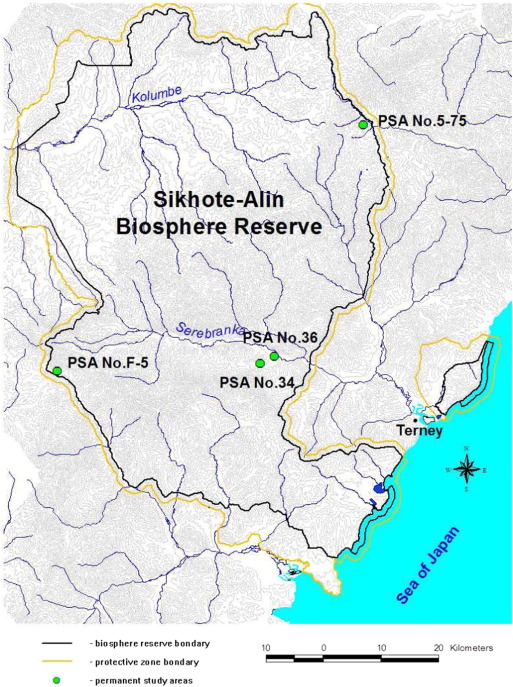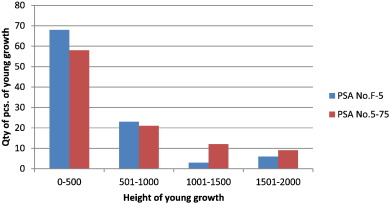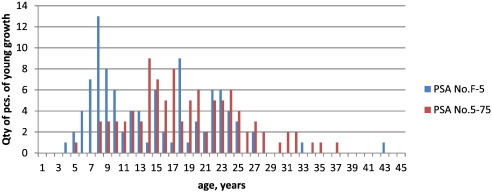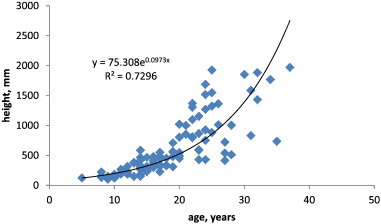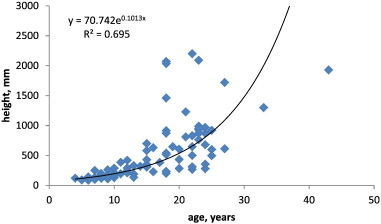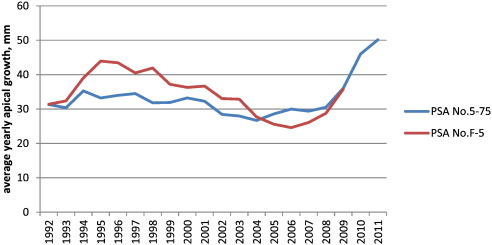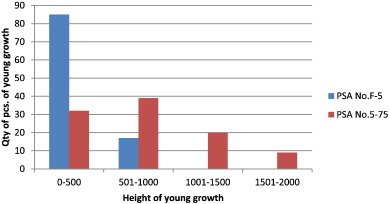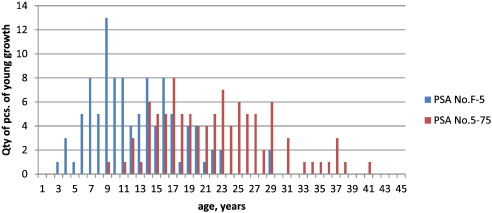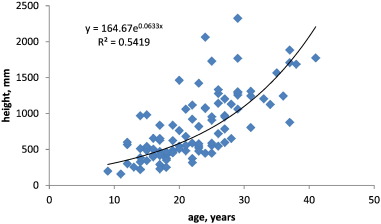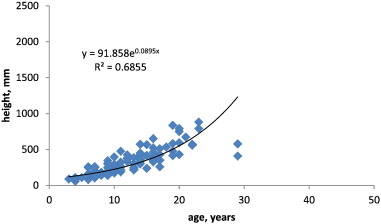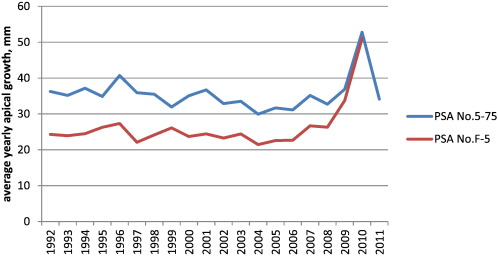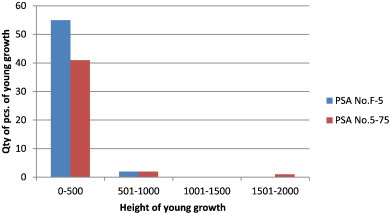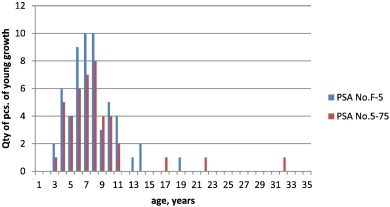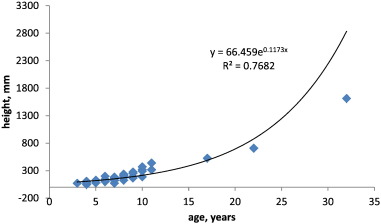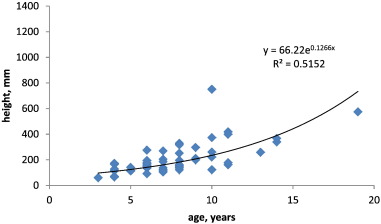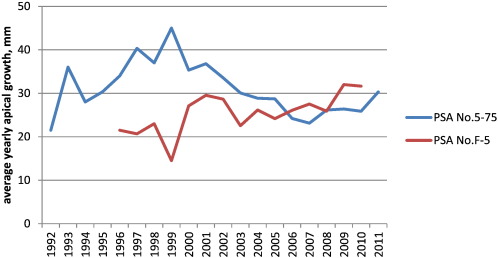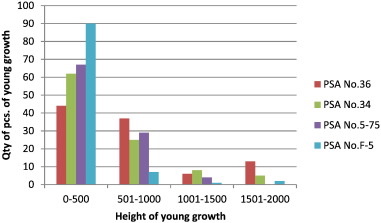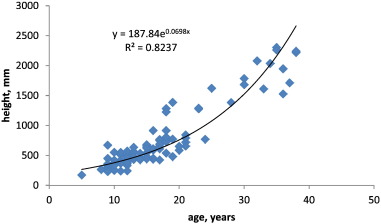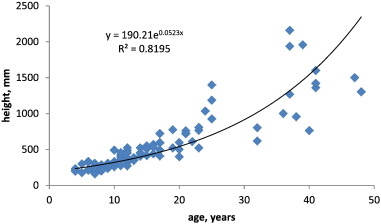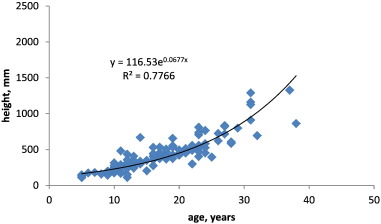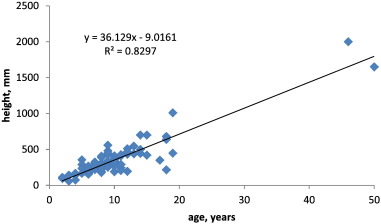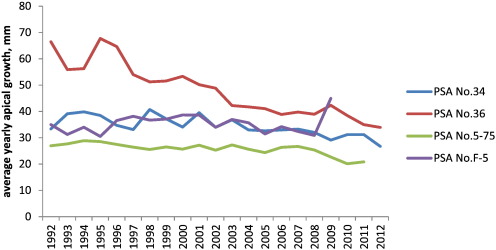Abstract
This paper presents the results of studies of the young growth of main forest-forming coniferous species in four types of native cedar forest of the Sikhote-Alin nature reserve. The following types of young growth were measured: Manchurian fir (Abies nephrolepis ), Ajan spruce (Picea ajanensis ), Japanese yew (Taxus cuspidata ), and Korean pine (Pinus koraiensis ). The research was conducted during 5 field seasons from 2008 to 2012 at 4 permanent study areas. For each species, the common silvicultural parameters, distribution of height, age of young growth and dynamics of the average apical growth data for the twenty-year period were identified and analysed. It was established that the size and strength of young growth are affected by complex forest site conditions that are determined by: the composition of the parent canopy, stand age, and position in the landscape. The growing conditions for young growth conifers are more favourable in mountain cedar forests compared to cedar forests in a valley. A parent canopy of a specific phytocenosis forms a unique microclimate, significantly weakening and softening the impact of macro-climate indicators of the growing area on the value of the apical growth of young growth. Spruce young growth is the most responsive to changes in climatic parameters and Korean pine young growth is the least responsive.
Keywords
Coniferous young growth ; Cedar ; Native forest ; Permanent study area ; Height ; Age ; Apical growth of young growth ; Microclimate dynamics
The young growth of trees is a constituting element in the soil-forming process. Growing under the canopy of the main stand, young growth experiences strong pressure from the surrounding phytocenosis. This has an effect on the growth and development of young growth, which represents the future of the forest. Therefore, it is necessary to study the dynamics of the formation of young growth under the canopy to identify the common development patterns of the future of the stand (Kulagin et al., 2007 ).
Studies of the structure and development of coniferous young growth were conducted by A.V. Smirnov Smirnov (1956) , Zubareva (1970) , Zlobin (1976) , Davydychev (2002) , Pats (2004) , Talantsev and Kulikov (1971) , Kulagin et al. (2007) , Chernyshev (1967) , Flyagina (1982) , Manko and Usoltsev (1999) , Ukhvatkina and Omelko (2011) and Omelko et al. (2013) . A detailed analysis of the height–age structure of the young growth of coniferous species was carried out by Martyanov (1978) . It was shown that this approach to young growth analysis provides not only the most complete picture of the long-term future of the forest but also allows a retrospective characterization of the forest phytocenosis. Analysis of the height–age structure helps to clarify how the different growing conditions affect the state of individual species within the forest growth area.
A key indicator of the life activities of a tree is its growth, i.e., the amount of organic material that is deposited yearly in its different parts. Growth is a complex index that not only synthesizes the results of the functioning of the body of a tree but also accumulates the impact of the environment on a tree (Smirnov, 1964 ). One of the main indicators of the growing power of young growth is its accretion in height because the function of the apical meristem is the quickest to respond to changes in site conditions (Bazunova, 1977 ). To study the factors that influence the value of the apical growth of young growth in detail, the effects of a number of biogeocenotic and climatic factors must be taken into consideration (Smirnov, 1964 ; Chernyshev, 1967 ; Chernyshev, 1973 ; Karmanova, 1970 ; Kukhta, 2003 ). This will reveal patterns in the formation of forests under different conditions for different ecosystems and allow for the prediction of their further development.
Sikhote-Alin nature reserve has been the site of research since 2007; the main goal of the research at this site is to identify the correlation between the apical growth of the young growth of the main tree species and the biogeocenotic factors in indigenous and longstanding forests. The results of studying the apical growth of Mongolian oak young growth under different site conditions and the impact of some of the biocenotic factors on it (in particular, sympodial apex growth as a result of bites by ungulates) were published in 2012 (Bondarchuk, 2012a ; Bondarchuk, 2012b ). From 2008 to 2012, research on the dynamics of the growth of the apical regrowth of main forest conifers was conducted in the nature reserve. The objectives included the identification of the growth conditions and general silvicultural parameters of young growth, determination of apical regrowth and identification of linear growth trends depending on biogeocenotic factors. This paper presents some of the results of the study of coniferous species young growth in the four types of indigenous forests in the Sikhote-Alin nature reserve. The analysis of the silvicultural parameters of young growth in the study area was carried out, and annual average apical growth for each species for twenty years was determined. The results obtained will be used to identify main biogeocenotic factors influencing the growth of young growth and reveal the degree of influence of these factors, as well as identify criteria for estimating increments of young growth and forest ecosystems as a whole.
Characteristics of Study Area
The study was conducted on the eastern macroslope of the Middle Sikhote-Alin. The Sikhote-Alin systems are located in an area of medium and low volcanic-humid mountains with a dominance of volcanic and erosion-alluvial morphostructures over cryosolic ones (Nikolskaya, 1982 ). The absolute height of terrain in the area is 200–600 m. The area is mainly composed of granite, granodiorite–porphyrite, lavas and liparite tuffs, liparite–dacite and dacite (Vetrennikov, 1976 ). The climate is monsoon with cold winters and rapid continentalization further from the sea. Climatic heterogeneity is also associated with the varied altitude and different orientations of the slopes.
According to the scheme of the vertical vegetation distribution in the Sikhote-Alin nature reserve by Kolesnikov (1938) , the study area belongs to a belt of cedar and broadleaved-cedar forests. According to the scheme of the types of cedar forests by Flyagina (1982) , the Sikhote-Alin nature reserve plant communities under study belong to the climate facies of medium cedar forests and have geomorphological complexes of mountain and lowland forests.
Field Methods
The work was carried out according to the methods developed in conjunction with the head of the Laboratory of Biogeography and Ecology of Pacific Institute of Geography, Far Eastern Branch of Russian Academy of Sciences, Sergei Vladimirovich Osipov.
The following types of conifers were selected for study: Korean pine (Pinus koraiensis ), Ajan spruce (Picea ajanensis ), Manchurian fir (Abies nephrolepis ), and Japanese yew (Taxus cuspidata ).
A permanent study area 50 × 50 m dimensions was divided by four profiles into five transects. From opposing sides of the area, the entire young growth of the selected tree species was measured and described, excluding shoots and individual trees exceeding 2 m in height; 50 pieces from each side of the area were measured and described for one species. The total number of measurements for each species was 100 pieces.
For each young growth specimen, the information was entered into a form containing a description of the young growth parameters (height, age, annual growth of apical sprout starting with the last year and ending with the year in which the accretion was still clearly visible, evidence of sympodial apex growth, whether it grew in a group or in isolation and years when the specimen reached the herb and shrub layers), biotic environment parameters (distance to the nearest medium or large young growth specimen, distance to two nearest trees and their diameters and heights, distance to the nearest tree of the same species and its diameter and height and density and height of the crown of the tree layer above the young growth specimen), and abiotic environment parameters (slope and surface exposure and position in nanorelief, nanorelief type and soil stoniness).
The general parameters of the biotic and abiotic environment (silvicultural characteristics and location) for the forest community were taken from the description of the permanent study area that was written according to the standard procedures when the permanent study area was formed and was updated with the results of the latest revision.
Statistical processing and analysis of the data was carried out using descriptive statistical methods in Microsoft Excel.
Results and Discussion
Data from 4 permanent study areas (Fig. 1 ) that were collected within 5 field seasons from 2008 to 2012 were processed. The young growth of 4 conifers was measured: Manchurian fir (200 specimens), Ajan spruce (202 specimens), Japanese yew (101 specimens), and Korean pine (400 specimens). A total of 903 specimens were measured. For each species, the common silvicultural parameters, growth trends, height and age distributions of young growth and annual average apical growth dynamics for the twenty-year period were identified and analysed.
|
|
|
Fig. 1. Layout of the permanent study areas in the Sikhote-Alin nature reserve. |
Description of the Permanent Study Areas:
Permanent Study Area No. 34
Name of association : mountain cedar forest with oak, small grass and dead soil . Geographical location : east macroslope of Sikhote-Alin in the middle of a steep slope on a low ridge (altitude of 350 m above sea level) that separates the valley of two small streams, Sukhoy and Zimoveyniy, and the right tributaries of Serebryanka River. Relief : southeast exposure of the slope, slope angle of 35°, rather flat surface, but there are slides and microelevations because of a loss of windfall trees. Soil : humic-illuvial weakly podzolic brown soil. Forest stand : main canopy consists of cedar and oak that are 24–28 m high. Secondary canopy is less clearly expressed and consists of 15 to 20 m high cedar and oak. The average diameter of dominating species is 32.2 cm, and the average height is 21.2 m; he average age is 200 years. Volume—349.94 m3 /ha; density—0.7; bonitet—III. Composition formula from the number of trees: 5 Korean pine, 5 Mongolian oak, isolated Ajan spruce, Amur linden, Asian white birch, painted maple—the 1st sub-layer; 8 Korean pine, 1 Mongolian oak, 1(Amur linden + painted maple + Asian white birch) + Manchurian fir, isolated Ajan spruce, mountain elm—the 2nd sub-layer. Young growth : cedar young growth is represented by three height–age categories, block planting in canopy windows. Oak young growth is mostly small, not higher than 25 cm, half of which is of vegetative origin formed in circles around the tree trunks. The young growth of other species is small, both in number and in height. Quantity (thousand pcs./ha): Korean pine—6.21; Mongolian oak—0.5; Ajan spruce—0.1; Manchurian fir—0.14; Dahurian larch—0.02; painted maple—0.2; Ukurundu maple—0.08; Amur linden—0.26; yellow birch—0.1; Asian white birch—0.02. Undergrowth : very rare, distributed unevenly over the area, includes Manchurian hazel, mock orange and euonymus. Grass cover: very sparse, does not form a closed canopy, typically includes sedges of xeromorphous type.
Permanent Study Area No. 36
Name of the association : valley cedar forest with linden . Geographical location : east macroslope of Sikhote-Alin, the second terrace above floodplain on the right bank of the Serebryanka River (altitude of 200 m above sea level) in the middle reach, between the Sukhoy and Zimoveyniy streams. Relief : heterogeneous, hummocky and gullied. Soil : brown and soddy soil on loamy sabulous talus. Forest stand : multi-species, multi-layered. 4 sub-layers are singled out. Volume: 264.3 m3 /ha. The average diameters of prevailing species of cedar, fir and linden are 20.1 cm, 21.2 cm and 10.8 cm, respectively. The largest reserves are in cedar—166.2 m3 /ha. The average age of the stand is 200 years; density—0.7; bonitet—II. Composition formula by the number of trees: 5 Korean pine, 3 Manchurian ash, 2 Maximovich poplar, isolated Asian white birch—the 1st sub-layer; 4 Amur linden, 2 Korean pine, 2 Manchurian ash, 1 Maximovich poplar, 1 Asian white birch + Manchurian fir—the 2nd sub-layer; 3 Manchurian fir, 2 Korean pine, 2 Amur linden, 2 painted maple, 1 Manchurian ash + Asian white birch, Japanese elm, Manchurian striped maple, isolated Ajan spruce, Koyama spruce, Maximovich poplar—the 3rd sub-layer; 4 Manchurian fir, 3 Korean pine, 1 painted maple, 1 Ukurundu maple, 1 (Amur linden + Manchurian striped maple) + Ajan spruce, Maximovich cherry, isolated Japanese elm—the 4th sub-layer. Young growth : presented by all height categories, both softwood and hardwood; the most abundant are Manchurian striped maple (2.13 thousand pcs./ha), Korean pine (0.34 thousand pcs./ha), Manchurian fir (0.28 thousand pcs./ha), Maximovich cherry (0, 26 thousand pcs./ha), and Ukurundu maple (0.22 thousand pcs./ha). The least abundant are Ajan spruce, yellow birch, Mongolian oak, and Japanese elm. Undergrowth : diverse, sometimes ample, includes 8 species of shrubs and 2 species of woody vines. Grass cover : high diversity, represented by 53 species. Among these, 9 species of ferns, 5 species of sedges, tall grasses, spring ephemeras and ephemeroids. In the 1930s, the future permanent study area was the site of selective logging.
Permanent Study Area No. 5-75
Name of the association : cedar forest with linden, yellow birch and Ajan spruce, mock orange and actinidia, with green moss, fern, and small grass . Geographical location : East macroslope of Sikhote-Alin, midstream basin of the Tayozhnaya River, the top of a low-angle watershed between the Krivoy and Bezimyanniy streams (height of 510 m above sea level). Relief : the surface is flat with a slight slope to the north. Soil : rocky soil with small amounts of skeletons, scarce rocks on the surface. Forest stand : overripe and complex in structure. The highest density and largest growing stock are concentrated in the first sub-layer, which is composed primarily of Korean pine with a small admixture of yellow birch. Korean cedar dominates in the second sub-layer as well, but up to two units of the number of trunks are hardwoods: Amur linden and yellow birch. The third sub-layer is the most diverse in composition, consisting of 12 tree species, including Japanese yew. The average diameter of the dominant species is 44.6 cm and the average height is 26.3 m; the average age is 300 years. Volume is 428.5 m3 /ha; density—1; bonitet—III. Composition formula from the number of trees: 10 Korean pine + yellow birch, isolated Amur linden—the 1st sub-layer; 6 Korean pine, 2 Manchurian fir, 1 Amur linden, 1 yellow birch + Ajan spruce, Maximovich cherry, Ukurundu maple, isolated Mongolian oak, aspen, Manchurian striped maple, painted maple—the 2nd sub-layer; 4 Manchurian fir, 2 Ajan spruce, 2 Ukurundu maple, 1 Amur linden, 1 yellow birch + Korean pine, Maximovich cherry, isolated Mongolian oak, Japanese yew, painted maple, Manchurian striped maple—the 3rd sub-layer. Young growth : significant proportion of Korean pine up to 50 cm tall (13.7 thousand specimens/ha). Manchurian fir (1.56 thousand specimens/ha), Ajan spruce (0.80 thousand specimens/ha), and Amur linden (2.11 thousand specimens/ha) all have young growth of different heights. There are small numbers of young growth of Mongolian oak (0.02 thousand specimens/ha), Japanese yew (0.05 thousand specimens/ha) and yellow birch (0.09 thousand specimens/ha) growing on forest fall with seed origins. Undergrowth : not abundant in this forest, but rather varied. It consists of 15 shrubs and vines. Among the latter, Actinidia kolomikta is abundant. Typical species: fine-leaved mock orange, Manchurian hazel, euonymus. Rare species include Korean abelia and daphne. The canopy density of the undergrowth is up to 0.3 and is uneven. Grass cover : up to 70% of the area. The bulk of grass stand is 25 cm tall. The grass is composed of 54 species, and the most frequent are ferns, Taiga small grass and small shrubs.
Permanent Study Area No. F-5
Name of the association : spruce and cedar forest with yew, fern and mixed herbs. Geographical location : East macroslope of Sikhote-Alin, the Dzhigitovka River basin, left bank of the lower reach of Kabaniy stream, lower third of the western exposure slope extending into in the terrace above flood-plain (height of 220 m above sea level). Relief : heterogeneous, uneven, with pits and microelevations because of a loss of windfall trees. Soil : rocky, loamy, shallow. Forest stand : overripe and complex in structure. Main canopy is dominated by cedar, Ajan spruce, fir and yellow birch; in the secondary canopy, the cedar share is reduced to isolated specimens because of a predominance of fir, spruce and hardwood. The bulk of the wood is concentrated in the main canopy. The average diameter of dominant species is 30.1 cm and the average height is 14.4 m; the average age is 300 years. Volume—369 m3 /ha, density—0.9. Composition formula by the number of trees: 4 Ajan spruce, 3 Manchurian fir, 1 Korean pine, 1 Manchurian striped maple, 1 (yellow birch + Ukurundu maple) + Japanese yew, Maximovich cherry, isolated Amur mountain ash. Young growth : young growth consists of (thousand specimens/ha): Korean pine—0.144; Manchurian fir—0.26; Ajan spruce—0.144; Japanese yew—0.016; yellow birch—0.596; Amur linden—0.02; Ukurundu maple—0.512; Manchurian striped maple—0.568; Maksimovich cherry—0.032; Amur mountain ash—0.004. Young growth is located in groups on fallen deadwood and forest fall. Evenly distributed across the area are rare large single specimens of oppressed young growth of Manchurian fir. Yellow birch and Ajan spruce grow abundantly on fallen trees, but only select specimens grow to average height. The young growth of yew usually only reaches a height of 0.5 m. The young growth of yellow and Manchurian striped maples of coppice origin are abundant in circles around parent tree trunks. Undergrowth : quite diverse in species. The dominant species are euonymuses, Maksimovich currant, with coralline honeysuckle and Maksimovich honeysuckle, Korean abelia, spirea, spiny eleuterococus. Non-layered vegetation is abundantly represented by kolomikta actinidia (2.28 thousand species/ha). Grass cover : up to 98% of the area. The bulk of the grass stand is 25–30 cm tall. The dominant species is fern Leptorumohra amurensis (90%).
Young Growth of Manchurian Fir
The young growth of Manchurian fir was measured in two types of cedar forests in permanent study areas No. 5-75 and No. F-5. Table 1 shows general silvicultural parameters of fir young growth and average yearly apical growth.
| Parameter | PSA No. F-5 | PSA No. 5-75 |
|---|---|---|
| Quantity, thousand pcs./ha | 0.26 | 1.56 |
| Average height, mm | 479.4 | 623.95 |
| Average age, years | 14.2 | 18.8 |
| Average yearly apical growth, mm | 32.5 | 33.1 |
As shown in Table 1 , from the natural regeneration scale presented by Nesterov (1948) , regeneration of fir in the valley of the spruce-cedar forest (PSA No. F-5) is poor because the quantity of 14-year old firs is less than one-thousand pieces per hectare. In the mountain cedar forest (PSA No. 5-75), regeneration is satisfactory, with an average age of 19; the quantity of young growth is almost 1500 pieces per hectare.
The average yearly apical growth at both study areas is almost the same, approx. 33 mm per year.
The distribution of the height of Manchurian fir young growth in two types of cedar forests is shown in Fig. 2 .
|
|
|
Fig. 2. Distribution of the height of Manchurian fir young growth in two permanent study areas (PSA No. 5-75 and PSA No. F-5). |
Small-sized fir young growth dominates in both permanent study areas, which corresponds to the balance of different generations of young growth under the canopy in undisturbed forest ecosystems. The quantity of medium and large young growth is almost three times lower; however, in the mountain cedar forest (PSA No. 5-75), its quantity is higher than in the valley, which suggests more favourable site conditions for the young growth of this height and also suggests the strength of the young growth of this height.
The distribution of the age of Manchurian fir young growth in two types of cedar forests is shown in Fig. 3 .
|
|
|
Fig. 3. Distribution of age of Manchurian fir young growth in two permanent study areas (PSA No. 5-75 and PSA No. F-5). |
According to the graph of the age distribution of fir in the valley cedar forest (PSA No. F-5), trees of younger age dominate compared to a mountain cedar forest. The bulk of young trees are 7–10 years old. In the mountain cedar forest, young growth aged 14–18 dominates, indicating a more advanced stage of formation.
Important conclusions can be drawn by comparing the patterns of correlation between the height of the young growth and age of the young growth in different ecological conditions. Fig. 4 shows the correlation between the height and age of fir young growth in a mountain cedar forest (PSA No. 5-75).
|
|
|
Fig. 4. Correlation between the height and age of Manchurian fir young growth in PSA No. 5-75. |
Fig. 5 shows the correlation between the height and age of fir young growth in a valley spruce and cedar forest (PSA No. F-5).
|
|
|
Fig. 5. Correlation between the height and age of Manchurian fir young growth in PSA No. F-5. |
With significant deviations at different locations, a rather strong exponential bond is observed (R2 = 0.7). After 35–40 years, the growth is significantly reduced. The weak correlation between height and age in this period may indicate a substantial diversity of conditions under the canopy. Although some individuals live up to 60 years in these conditions, they are barely “surviving” in anticipation of the time when, perhaps, older generation trees will begin to fall and they will be able to replace them.
The average yearly apical growth of the fir undergrowth was also measured and analysed. Its dynamics over a 20-year period in two permanent study areas is shown in Fig. 6 .
|
|
|
Fig. 6. Dynamics of the average yearly apical growth of Manchurian fir in two permanent study areas from 1992 to 2011. |
Apical growth in a mountain cedar forest (PSA No. 5-75) from the study period to 2008 is quite stable without significant trends. The accretion value is in the interval of 25 to 35 mm. Increased apical growth has been observed since 2009. By 2011, it reached the value of 50.2 mm, with a long-term average of 33.1 mm. In valley conditions (PSA No. F-5), a gradual decline in the average value of apical growth was observed from 1996 until 2006, with minimum accretion constituting 24.6 mm and a long-term average of 32.5 mm. After 2006, a smooth increase of apical growth values was observed again.
Young Growth of Ajan Spruce
Ajan spruce was measured in two types of cedar forests in PSA No. 5-75 and PSA No. F-5. The general silvicultural parameters of spruce young growth and average yearly apical growth data are presented in Table 2 .
| Parameter | PSA No. F-5 | PSA No. 5-75 |
|---|---|---|
| Quantity, thousand pcs./ha | 0.144 | 0.80 |
| Average height, mm | 327.1 | 795.6 |
| Average age, years | 12.5 | 22.3 |
| Average yearly apical growth, mm | 26.2 | 35.7 |
Regeneration of spruce in the valley spruce and cedar forest (PSA No. F-5) is poor; according to the natural regeneration scale by Nesterov (1948) , the quantity of trees aged 12.5 years on average is less than 0.5 thousand pieces per hectare. In the mountain cedar forest (PSA No. 5-75), regeneration is weak; with an average age of 22, the quantity of young growth is 800 pieces per hectare.
The average long-term apical growth of spruce in the valley spruce-cedar forest is noticeably inferior to apical growth values in the mountain forest. This indicates that trees of different ages prevail in each forest type under study and that growth conditions vary.
The distribution of the height of the Ajan spruce young growth in two types of cedar forests is shown in Fig. 7 . As shown, with a canopy density of 70%, young growth of all heights is present in the mountain cedar forest. Young growth up to 1 m tall is the most plentiful, but both small and large young growth is present, which suggests its strength. It is different in the valley forest. Young growth taller than 1 m is totally absent here. This may be the result of a rather dense crown cover of the upper layer, which constitutes approximately 90%, as well as a thick grass layer formed by the fern L. amurensis . Biologically, Ajan spruce is a shade tolerant species, but it is inferior in this respect to fir and yew. Apparently, the lack of solar radiation has a detrimental effect on young plants that are also suffering from late spring frosts that are common in the area. Therefore, at the sprouting stage and in the first few years of life, young plants are present in the area, but then almost completely die or grow very slowly and remain stunted for a long time. A balanced ratio of different generations of spruce can be restored only when the upper tree layer starts to decay.
|
|
|
Fig. 7. Distribution of the height of Ajan spruce young growth in two permanent study areas (PSA No. 5-75 and PSA No. F-5). |
The distribution of the age of Ajan spruce young growth in two types of cedar forests is shown in Fig. 8 .
|
|
|
Fig. 8. Distribution of the age of Ajan spruce young growth in two permanent study areas (PSA No. 5-75 and PSA No. F-5). |
According to the graph of the age distribution of spruce in the valley cedar forest (PSA No. F-5), younger aged trees dominate compared to a mountain cedar forest. The bulk of young trees are 7–17 years old. In the mountain cedar forest, more mature young growth aged 14–30 years old dominates. Additionally, there is a significant amount of slow-growing young growth of 30 years and older that cannot reach the upper layers because of strong oppression by the parent canopy.
Fig. 9 shows the correlation between the height and age of spruce young growth in a mountain cedar forest (PSA No. 5-75).
|
|
|
Fig. 9. Correlation between the height and age of Ajan spruce young growth in PSA No. 5-75. |
Fig. 10 shows the correlation between the height and age of spruce young growth in a valley spruce and cedar forest (PSA No. F-5).
|
|
|
Fig. 10. Correlation between the height and age of Ajan spruce young growth in PSA No. F-5. |
With significant deviations at different locations, a rather strong exponential bond is observed similar to the Manchurian fir: R2 = 0.5 at PSA No. 5-75 and R2 = 0.7 at PSA No. F-5.
The dynamics of the average yearly apical growth of Ajan spruce young growth over a 20-year period in two permanent study areas is shown in Fig. 11 . As shown in the graph, apical growth during the study period from 1992 to 2008 is quite stable. The accretion value is in the interval from 25–35 mm in the mountain cedar forest and 20–30 mm in the valley forest. Over the two years after 2009, there was a dramatic increase in the value of apical growth in both permanent study areas that is obviously related to significant climate changes in the general area.
|
|
|
Fig. 11. Dynamics of the average yearly apical growth of Ajan spruce in two permanent study areas from 1992 to 2011. |
Young Growth of Japanese Yew
Japanese yew was measured in two types of cedar forests in PSA No. 5-75 and PSA No. F5. The general silvicultural parameters of yew young growth and the average yearly apical growth data are presented in Table 3 .
| Parameter | PSA No. F-5 | PSA No. 5-75 |
|---|---|---|
| Quantity, thousand pcs./ha | 0.016 | 0.05 |
| Average height, mm | 201.2 | 227.7 |
| Average age, years | 7.6 | 8.2 |
| Average yearly apical growth, mm | 26.6 | 27.6 |
It is well known that Japanese yew does not form independent forest stands and grows singly or in groups of different aged trees in mixed coniferous and hardwood forests. Therefore, full regeneration of yew is not possible. The quantity of yew young growth is three times higher in the mountain cedar forest than in the valley forest, with 50 and 16 specimens per hectare, respectively. The height of the young growth, its age and the average long-term apical growth are about the same, as shown in Table 3 .
The distribution of height of Japanese yew young growth in two types of cedar forests is shown in Fig. 12 .
|
|
|
Fig. 12. Distribution of the height of Japanese yew young growth in two permanent study areas (PSA No. 5-75 and PSA No. F-5). |
It is worthwhile to note that in both study areas there is almost no medium or large yew young growth; this lack of medium and large young growth is typical for yew because it is heavily damaged by ungulate animals at a young age.
The distribution of the age of Japanese yew young growth in two types of cedar forests is shown in Fig. 13 .
|
|
|
Fig. 13. Distribution of the age of Japanese yew young growth in two permanent study areas (PSA No. 5-75 and PSA No. F-5). |
Yew young growth is about the same age in both study areas. Plants aged 4–10 years old are the greatest in numbers. Only several specimens in the mountain cedar forest were aged more than 20 or 30 years. No young growth specimens over 20 years old were found in the valley forest.
Fig. 14 shows the correlation between the height and age of yew young growth in the mountain cedar and linden forest.
|
|
|
Fig. 14. Correlation between the height and age of Japanese yew young growth in PSA No. 5-75. |
Fig. 15 shows the correlation between the height and age of yew young growth in the valley spruce and cedar forest.
|
|
|
Fig. 15. Correlation between the height and age of Japanese yew young growth in PSA No. F-5. |
A strong exponential correlation between the age and height of Japanese yew is observed in both study areas: R2 = 0.8 at PSA No. 5-75 and R2 = 0.5 at PSA No. F-5.
The dynamics of the average yearly apical growth of Japanese yew young growth over a 20-year period in two permanent study areas is shown in Fig. 16 . Until 2000, the growth conditions at the study areas test plots were the opposite. This was mainly a result of the microclimate parameters of specific phytocenoses. At PSA No. 5-75, the accretion of young growth significantly exceeded that at PSA No. F-5, constituting 30–40 mm and 20–30 mm, respectively. Since 2001, the value of apical growth in both areas has stabilized, remaining in the range of ~ 20–30 mm.
|
|
|
Fig. 16. Dynamics of the average yearly apical growth of Japanese yew young growth in two permanent study areas from 1992 to 2011. |
Young Growth of Korean Pine
Korean pine young growth was measured in four types of cedar forests in PSA No. 5-75, PSA No. F5, PSA No. 34, and PSA No. 36. The general silvicultural parameters of pine young growth and average yearly apical growth data are presented in Table 4 .
| Parameter | PSA No. F5 | PSA No. 5-75 | PSA No. 34 | PSA No. 36 |
|---|---|---|---|---|
| Quantity, thousand pcs./ha | 0.144 | 3.17 | 0.34 | 6.2 |
| Average height, mm | 346.5 | 445.0 | 737 | 548 |
| Average age, years | 9.8 | 17.5 | 16.7 | 16.1 |
| Average yearly apical growth, mm | 35.5 | 25.0 | 44.8 | 33.3 |
From the natural regeneration scale that was presented by Nesterov (1948) , good regeneration is observed in two types of cedar forests (PSA No. 5-75 and PSA No. 36). More than 3 thousand specimens per hectare of pine young growth were found here. Poor regeneration was observed in the valley spruce and cedar forest (PSA No. F-5) and in mountain cedar and oak forest (PSA No. 34). In the latter forest, the quantity of Korean pine was less than 500 pieces per hectare. The largest value of average yearly apical growth is in the mountain cedar and oak forest in PSA No. 34, constituting 44.8 mm. The smallest value of apical growth, 25 mm, is in the mountain cedar and linden forest in PSA No. 5075.
The distribution of the height of Korean pine young growth in four types of cedar forests is shown in Fig. 17 .
|
|
|
Fig. 17. Distribution of the height of Korean pine young growth in four permanent study areas. |
In all of the cedar forests under study, the Korean pine young growth is distributed evenly height-wise. Young growth up to 50 cm tall is the most plentiful, which is normal for indigenous forest types. The remaining height categories are presented in descending order. In PSA No. 5-75, in the mountain cedar and linden forest, young growth taller than a metre and a half is completely absent, and in PSA No. 36, in the valley cedar and linden forest, the quantity of this young growth is higher than in other areas, which indicates its strength.
The distribution of age of Korean pine young growth in four types of cedar forests is shown in Fig. 18 .
|
|
|
Fig. 18. Distribution of the age of Korean pine young growth in four permanent study areas. |
The age distribution of pine indicates that certain age categories dominate in each type of cedar forest, but the bulk of young growth in all of the study areas, approximately 62%, is in the range of 7 to 17 years. Young growth that is 9–18 years old dominates in the valley cedar and linden forest (PSA No. 36). There is also a sufficient amount (14%) of slow-growing young growth aged 25–40 years old that did not rise to the upper canopy because of strong suppression. A similar group of slow-growing specimens aged from 35 to 50 was found in the mountain cedar and oak forest (PSA No. 34), constituting approximately 12% of the total amount. The largest amount of young growth (71%) was observed in the valley fir and cedar forest (PSA No. F-5). Young growth aged from 10 to 25 years old dominates in the mountain cedar and linden forest (75%).
The graphs (Fig. 19 , Fig. 20 ; Fig. 21 ) reveal the patterns of connection between the height and age of Korean pine young growth in the forest types under study. Clear exponential dependence of R2 = 0.8 is observed in areas where young growth is represented by all age and height categories (Fig. 19 , Fig. 20 ; Fig. 21 ). The dependence is linear (R2 = 0.8) in the spruce and cedar forest (Fig. 22 ) where the young growth is mainly of a younger age.
|
|
|
Fig. 19. Correlation between the height and age of Korean pine young growth in PSA No. 36. |
|
|
|
Fig. 20. Correlation between the height and age of Korean pine young growth in PSA No. 34. |
|
|
|
Fig. 21. Correlation between the height and age of Korean pine young growth in PSA No. 5-75. |
|
|
|
Fig. 22. Correlation between the height and age of Korean pine young growth in PSA No. F-5. |
The dynamics of the average yearly apical growth of Korean pine young growth over a 20-year period is shown in Fig. 23 .
|
|
|
Fig. 23. Dynamics of the average yearly apical growth of Korean pine young growth in four permanent study areas from 1992 to 2012. |
The value of the apical growth of pine young growth remains stable over time in indigenous phytocenoses (PSA No. 34, No. 5-75, No. F-5), with a range of 20 to 45 mm.
The situation is different in partially disturbed forest stands. In phytocenoses where selective logging once took place (PSA No. 36), the value of apical growth is falling, possibly as a result of the gradual closing of the upper layer crowns because young pine specimens require significantly more light for growth compared to other conifers. The maximum growth, 67.7 mm, was recorded in 1995; the minimum growth, 33.9 mm, was recorded in 2012. The average increment egression of young growth in the given period is 1.5 mm per year.
In 2009, the accretion of pine increased only in one study area (PSA No. F-5), up to 44.9 mm, with an average of 35.5 mm, and no significant increase in apical growth was observed in other types of studied phytocenosises. This makes it possible to state that smooth micro-climatic conditions formed by the parent canopy are more important for pine young growth than the macroclimate conditions of the area.
Conclusion
The structure of the parent canopy, age of the forest stand and its position in the landscape define the unique set of site conditions that affect the abundance and strength of young growth, in addition to the intensity of the apical growth of the young growth in the studied types of indigenous forests.
Growing conditions for coniferous young growth are more favourable in geomorphological complexes of mountain cedar forests than in valley cedar forests.
The parent canopy of a particular ecological community creates its unique microclimate, noticeably weakening and smoothing the impact of the macroclimate indicators of the growing area on the value of the apical growth of the conifer young growth under study. Spruce young growth is most responsive to changes in climatic parameters, while Korean pine young growth is the least responsive.
References
- Bazunova, 1977 G.G. Bazunova; Morphological parameters of vegetative shoots of coniferous young growth; Stationary Studies in the Forests of Sikhote-Alin, FESC USSR Academy of Sciences, Vladivostok (1977), pp. 52–58 (in Russian)
- Bondarchuk, 2012a S.N. Bondarchuk; Research of apical growth of Mongolian oak young growth (Quercus mongolica Fisch . Ex Ledeb.) at study areas in Sikhote-Alin nature reserve ; Sikhote-Alin biosphere area: condition of ecosystems and their components: collection of scientific papers: the 75th anniversary of Sikhote-Alin nature reserveDalnauka, Vladivostok (2012), pp. 62–80 (in Russian)
- Bondarchuk, 2012b S.N. Bondarchuk; Influence of ungulates on the value of apical growth of Mongolian oak young growth in oak forests in the coastal zone of Sikhote-Alin nature reserve; Proceedings of the international scientific conference “Protection and research at specially protected natural sites of the Far East and Siberia”, dedicated to the 25th anniversary of Bureinski State natural reserve (2012), pp. 16–19 (Khabarovsk, in Russian)
- Chernyshev, 1967 V.D. Chernyshev; Characteristics of growth conditions of young growth under the canopy of mixed forest; Complex Stationary Study of Forests of Primorye, Science Publishing House, Leningrad Department, Leningrad (1967), pp. 115–121 (in Russian)
- Chernyshev, 1973 V.D. Chernyshev; Phyto-climatic conditions of growth and development of young growth in broadleaf and coniferous forests of southern Primorye; Hydroclimatic Studies of the Forests of the Soviet Far East, Far Eastern Scientific Center, Academy of Sciences of the USSR, Vladivostok (1973), pp. 31–54 (in Russian)
- Davydychev, 2002 A.N. Davydychev; Characteristics of development of Siberian spruce (Picea obovata Ledeb.) young growth and Siberian fir (Abies sibirica Ledeb.) young growth in water-protection forest of Ufimskoe plateau ; Biota of mountain areas: history and current status, Materials Conf. Young Scientists, 15–19 April 2002. IPAE UB RAS, Akademkniga Publishing House, Ekaterinburg (2002), pp. 46–47 (in Russian)
- Flyagina, 1982 I.A. Flyagina; Reproduction of Cedar Forests at Eastern Slopes of Sikhote-Alin; Far Eastern Scientific Center, Academy of Sciences of the USSR, Vladivostok (1982) (180 pp., in Russian)
- Karmanova, 1970 I.V. Karmanova; Influence of environmental factors on the growth and productivity of young growth of some trees; Natural Regeneration of Trees and Quantitative Analysis of its Growth, Science, Moscow (1970), pp. 85–114 (in Russian)
- Kolesnikov, 1938 B.P. Kolesnikov; Vegetation of eastern slopes of central Sikhote-Alin; Proc. Sikhote-Alin State natural reserve, vol. 1 (1938), pp. 25–207 (in Russian)
- Kukhta, 2003 A.E. Kukhta; Linear accretion of trees as an indicator of the state of environment; Siberian Journal of Ecology, Vol. X, Publishing House of SB RAS, Novosibirsk (2003), pp. 649–658 (No. 6, in Russian)
- Kulagin et al., 2007 A.Yu Kulagin, A.N. Davydychev, E.M. Dorozhkin, D.G. Askarov; Analysis of height and age structure of young growth of broadleaf species in water-protection forests of Pavlovsk water reservoir; Proceedings of Samara Scientific Center of Russian Academy of Sciences, vol. 9 (2007), pp. 107–121 (No. 1, in Russian)
- Manko and Usoltsev, 1999 Yu.I. Manko, V.M. Usoltsev; Monitoring of preliminary young growth of Ajan spruce and Manchurian fir in central Sikhote-Alin; Forests and Forest Formation Processes in the Far East (1999), pp. 150–151 (Vladivostok, in Russian)
- Martyanov, 1978 N.A. Martyanov; Analysis of height an age structure of young growth of conifers in various types of coniferous forests; Ecology of Conifers, Bashkir Branch of AS USSR, Ufa (1978) (in Russian)
- Nesterov, 1948 V.G. Nesterov; Method of study of natural regeneration of forests; ProceedingsSiberian Institute of, Forestry, Krasnoyarsk (1948), pp. 25–36
- Nikolskaya, 1982 V.V. Nikolskaya; South of the Far East; Far East and the Shores of the Seas Surrounding the Territory of the USSR. M (1982), pp. 155–194 (in Russian)
- Omelko et al., 2013 A.M. Omelko, O.N. Ukhvatkina, A.A. Zhmerenetskiy, V.S. Gusev; Regeneration of Coniferous Species in Cedar and Broadleaf Forests of the Southern Russian Far East: Age Structure of Young Growth; Fundamentalnye Issledovania (2013), pp. 943–947 (No. 11, in Russian)
- Pats, 2004 E.N. Pats; Morphological Structure of Cedar Young Growth at the Upper Boundary of a Forest; Silviculture (2004), pp. 13–16 (No. 6, in Russian)
- Smirnov, 1956 A.V. Smirnov; Regeneration of Cedar in East Siberia; Silviculture (1956), pp. 17–20 (No. 4, in Russian)
- Smirnov, 1964 V.V. Smirnov; Seasonal Growth of Main Tree Species; Science, Moscow (1964) (168 pp. in Russian)
- Talantsev and Kulikov, 1971 N.K. Talantsev, M.I. Kulikov; Natural regeneration of lowland taiga cedar forests and the role of young growth in forming the future tree stands; G.V. Krylov (Ed.), The Use and Reproduction of Cedar Forests, Science, Novosibirsk (1971), pp. 189–198 (in Russian)
- Ukhvatkina and Omelko, 2011 O.N. Ukhvatkina, A.M. Omelko; The structure of young growth and natural regeneration in a mixed coniferous and deciduous forest of southern Sikhote-Alin; Journal of Siberian Federal University. Series: Biology (2011), pp. 266–280 (No. 3., in Russian)
- Vetrennikov, 1976 V.V. Vetrennikov; Geological Structure of Sikhote-Alin State Natural Reserve and Central Sikhote-Alin; Far Eastern Publishing House, Vladivostok (1976) 168 p. [in Russian]
- Zlobin, 1976 Yu.A. Zlobin; Assessment of Quality of Cenopopulations of Young Growth of Tree Species; Silviculture (1976), pp. 72–79 (No. 6., in Russian)
- Zubareva, 1970 R.S. Zubareva; Characteristics of development of young generations of spruce and fir in the broad-leaved and dark coniferous forests of the Middle Urals; Proc. Inst. of Plant and Animal Ecology of Ufa Research Center, Academy of Sciences USSR, vol. 77 (1970) (in Russian)
Document information
Published on 27/03/17
Licence: Other
Share this document
Keywords
claim authorship
Are you one of the authors of this document?
